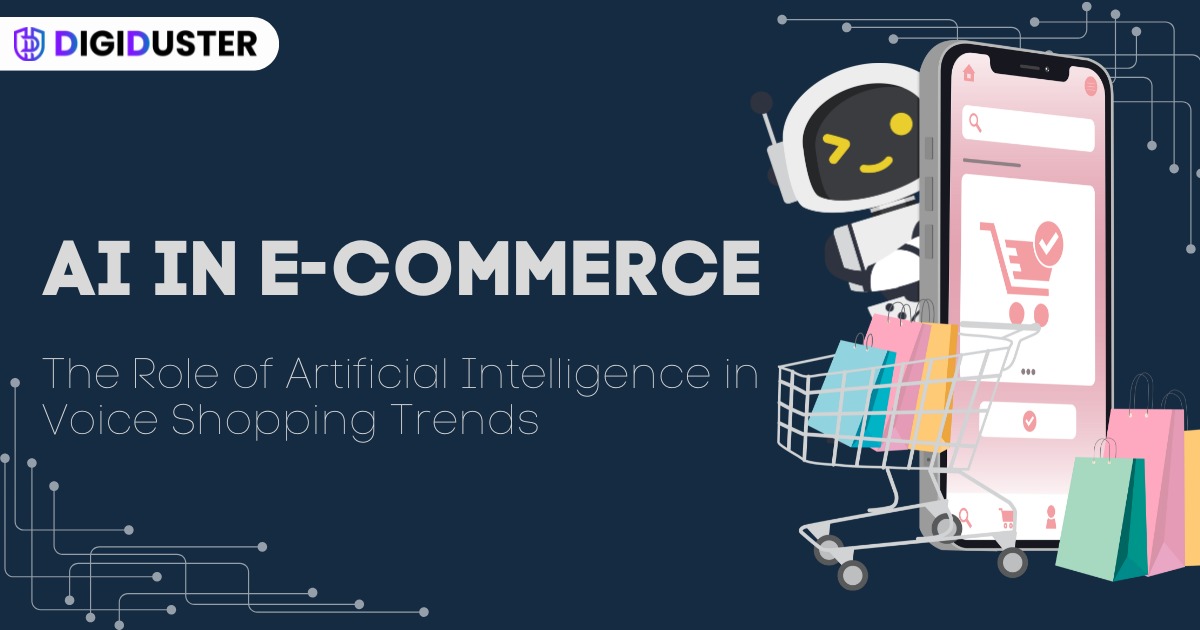Artificial Intelligence (AI) is changing how we shop online. From personalized recommendations to automated customer service, AI has made e-commerce smarter and more efficient. One of the latest trends in this revolution is voice shopping—a hands-free, fast, and convenient way to shop using AI-powered voice assistants. Let’s cover how AI in e-commerce plays a vital role in voice shopping.
Voice shopping is becoming popular with devices like Amazon Alexa, Google Assistant, and Apple’s Siri. These smart assistants let users search for products, compare prices, and even place orders just by speaking. Imagine saying, “Alexa, reorder my favorite coffee,” and within seconds, it’s done!
According to recent stats, 38.8 million Americans used smart speakers for shopping in 2023. This number is expected to grow as more people adopt AI-driven shopping habits. With machine learning and e-commerce working together, businesses can now offer a seamless, voice-powered shopping experience.
But how does voice shopping work? And why is it changing the e-commerce landscape? Let’s find out.
What is Voice Shopping?
Voice shopping, also known as voice commerce, allows users to shop online using voice commands. Instead of typing and clicking, shoppers simply speak to their smart devices to search, select, and buy products.
At the heart of voice shopping is Natural Language Processing (NLP)—an AI technology that helps machines understand human speech. With AI in e-commerce, voice assistants can recognize voices, process commands, and even learn shopping preferences.
This hands-free shopping method is gaining popularity because it’s easy and convenient. Whether you’re driving, cooking, or just relaxing, voice shopping allows you to make purchases without touching your phone or laptop.
The Key Role of AI in Voice Shopping
AI plays a huge role in voice commerce. Here’s how it’s transforming the shopping experience:
1. Personalized Shopping Experiences
AI analyzes past purchases, browsing history, and user behaviour to offer tailored product recommendations. If you regularly buy skincare products, your voice assistant might suggest a new brand or remind you to restock.
2. Faster & More Convenient Checkouts
No more entering payment details manually. AI-powered voice assistants store payment information securely, allowing one-command checkouts. A simple “Hey Google, buy my usual detergent” can place an order instantly.
3. Smart Reorders & Predictive Buying
AI predicts what customers need before they even realize it. Based on past purchases, it can remind users to reorder items or suggest complementary products.
Read also: How to Secure Your Small Business from Cyber Threats
4. Fraud Detection & Secure Payments
Voice authentication and AI-driven fraud detection help ensure secure transactions. AI can recognize voice patterns to prevent unauthorized purchases, making voice commerce safer.
How Voice Shopping is Changing E-commerce Trends
1. Increased Adoption of Smart Speakers
More households are using smart speakers like Amazon Echo, Google Nest, and Apple HomePod. As these devices become more affordable and accessible, voice shopping will continue to grow.
2. Seamless Multichannel Shopping
AI bridges the gap between voice, mobile, and desktop shopping. You might add items to your cart via voice assistant and complete the purchase on your phone. This smooth shopping experience increases sales and customer satisfaction.
3. Hyper-Personalization in Marketing
AI enables businesses to create voice-driven ads and personalized promotions. Imagine hearing, “Hey Alexa, your favorite sneakers are on sale!” AI-powered marketing strategies will make shopping even more engaging.
4. Voice-Activated Search Optimization
More shoppers are using voice search to find products, forcing businesses to optimize content for voice queries. Brands must focus on natural, conversational keywords instead of traditional SEO tactics.
5. AI-Powered Customer Support
AI-driven voice assistants now handle customer inquiries, process returns, and provide shopping recommendations, reducing the need for human customer support.
6. Growth in Voice-Only Deals & Promotions
Retailers are offering exclusive voice shopping discounts, encouraging more customers to use smart speakers for purchasing. This trend is driving higher engagement and sales.
Challenges & Limitations of AI in Voice Shopping
1. Understanding Complex Queries
AI is still learning to understand different accents, slang, and complex commands. While it’s improving, occasional errors can lead to incorrect product selections.
2. Privacy & Security Concerns
Many consumers worry about data privacy. Since voice assistants record conversations, people fear misuse of personal data. Companies need to ensure secure data handling and transparent policies.
3. Adoption Barriers
Some consumers still prefer traditional online shopping. The lack of a visual interface makes it harder to compare products, read reviews, or check details before purchasing.
4. Limited Product Browsing Experience
Unlike visual shopping, voice shopping doesn’t allow users to compare multiple products easily, making it less effective for categories requiring detailed evaluation.
Read also: Advantages & Disadvantages of Cloud Computing for Small Businesses
5. Accent & Language Recognition Issues
Voice assistants still struggle with regional accents, dialects, and multilingual commands, limiting accessibility for diverse consumers.
6. Dependence on Smart Speaker Adoption
While growing, smart speaker usage is not universal. Many shoppers still prefer traditional online browsing, slowing the adoption of voice commerce.
Future Trends: Where AI & Voice Commerce Are Heading
1. AI-powered Multilingual Voice Shopping
Voice assistants will support more languages, breaking language barriers and making AI in e-commerce truly global.
2. Integration with AR & VR
Augmented Reality (AR) and Virtual Reality (VR) will merge with voice shopping, allowing users to see products before buying, all through voice commands.
3. Predictive Voice AI
Future AI-powered voice assistants will predict needs before users ask. Imagine getting a reminder, “You’re running low on milk. Should I order more?” This next-level automation will revolutionize shopping.
Career Opportunities in Information Technology for Beginners
4. Conversational AI for Interactive Shopping
AI will enhance conversations, allowing users to ask follow-up questions, refine choices, and get personalized shopping advice in real-time.
5. Voice Commerce for Wearables & IoT Devices
Smartwatches, smart glasses, and IoT-enabled home devices will integrate voice shopping, making hands-free purchases even more accessible.
6. Enhanced AI-Powered Voice Search for Local Shopping
AI will enable hyper-localized voice shopping, helping users find nearby stores, check product availability, and order for same-day pickup.
Conclusion: Is Your Business Ready for AI in Voice Shopping?
AI-driven voice commerce is the future of online shopping. With smart recommendations, fast checkouts, and enhanced personalization, it’s changing how consumers shop.
For businesses, adopting AI in e-commerce means staying ahead of competitors and providing seamless shopping experiences. If you haven’t yet explored AI-powered voice shopping solutions, now is the time to integrate them into your e-commerce strategy!



